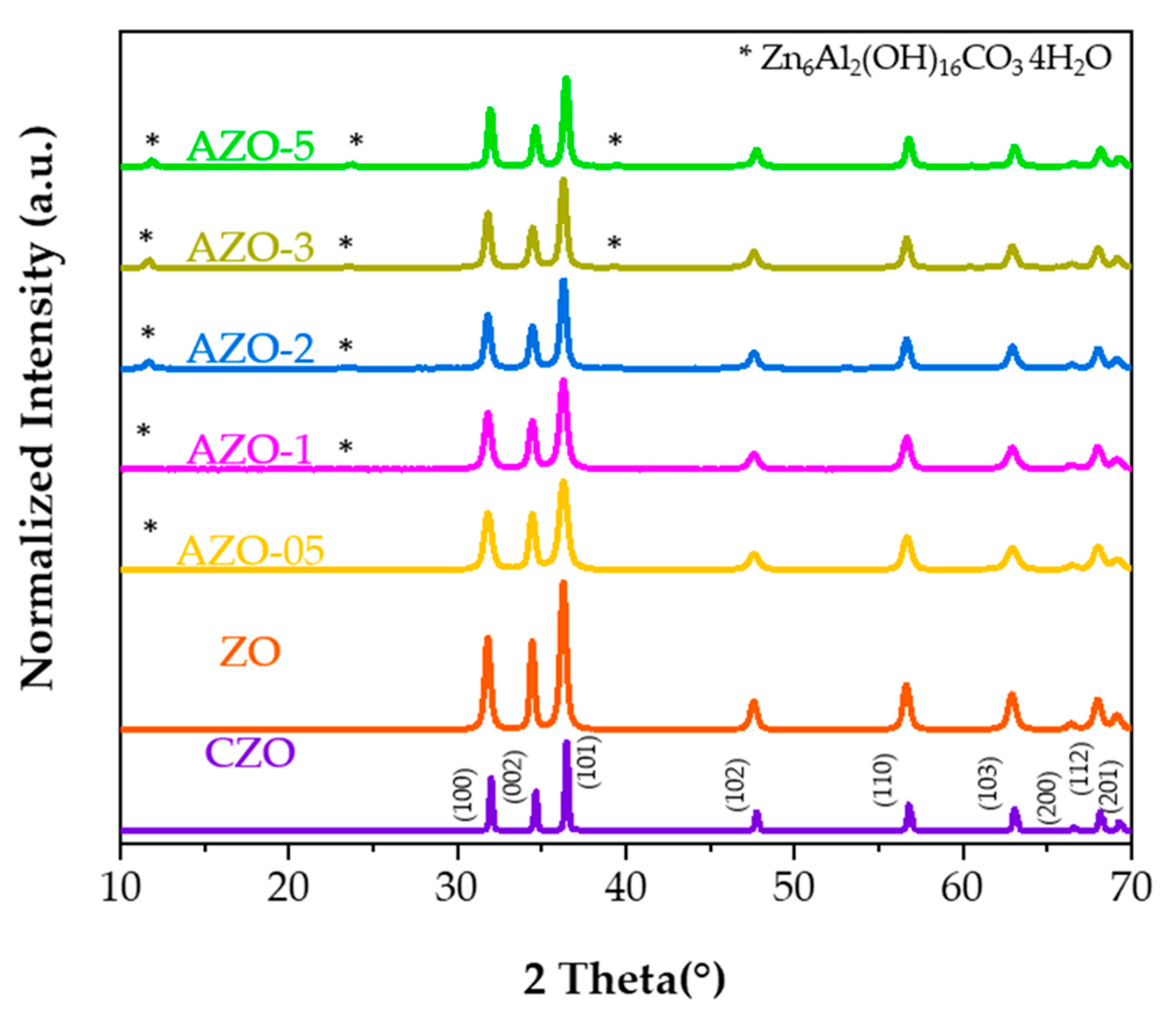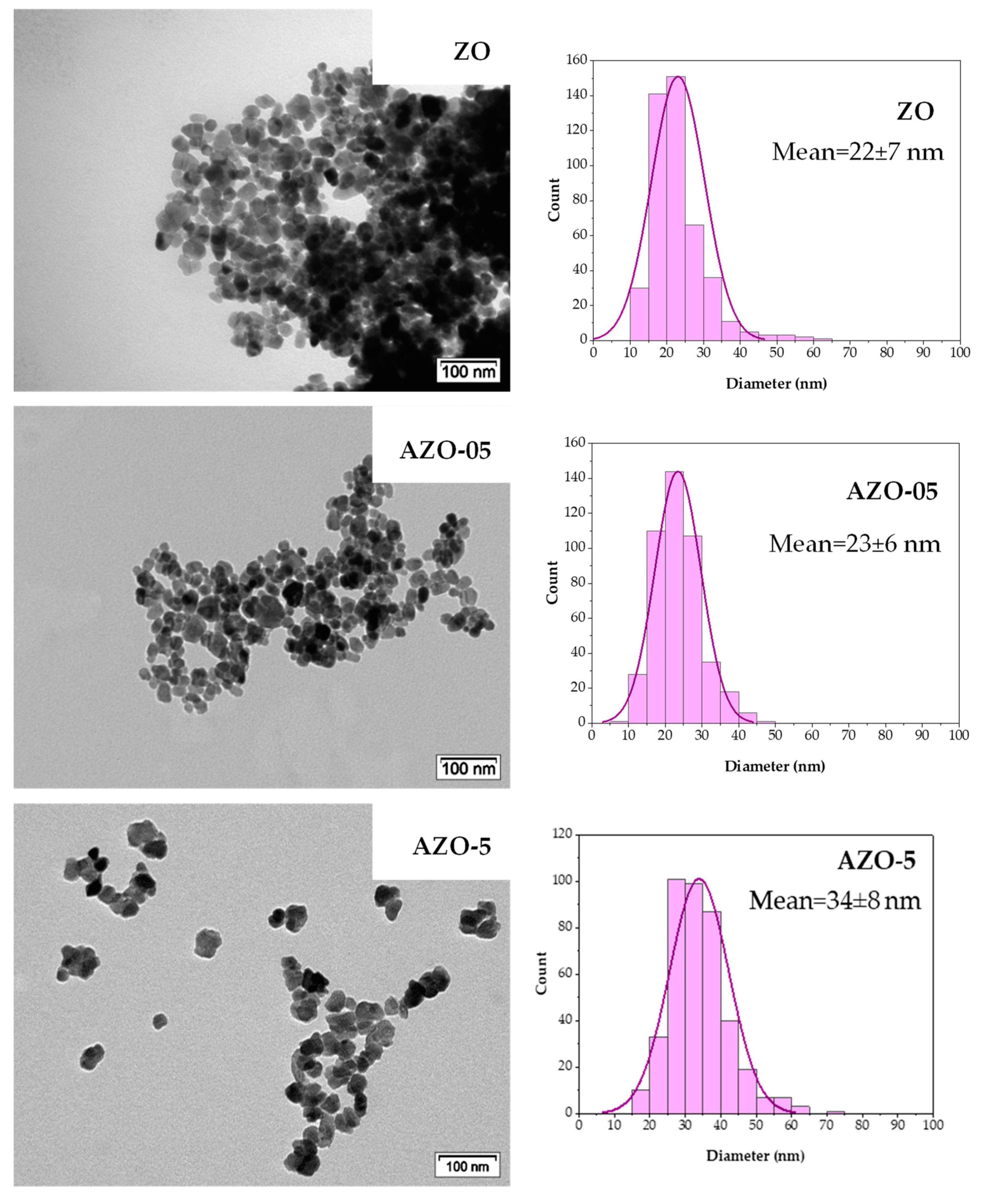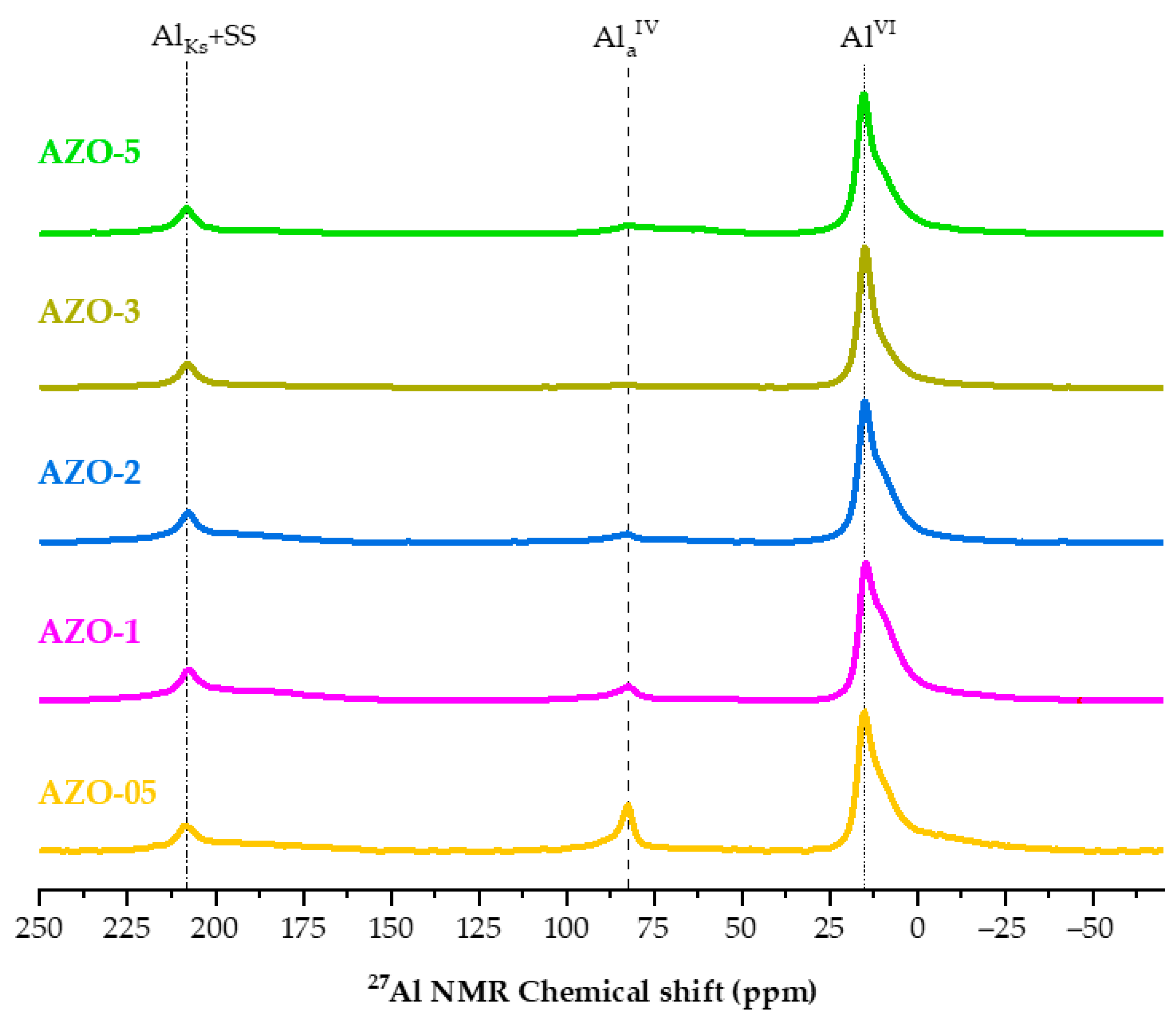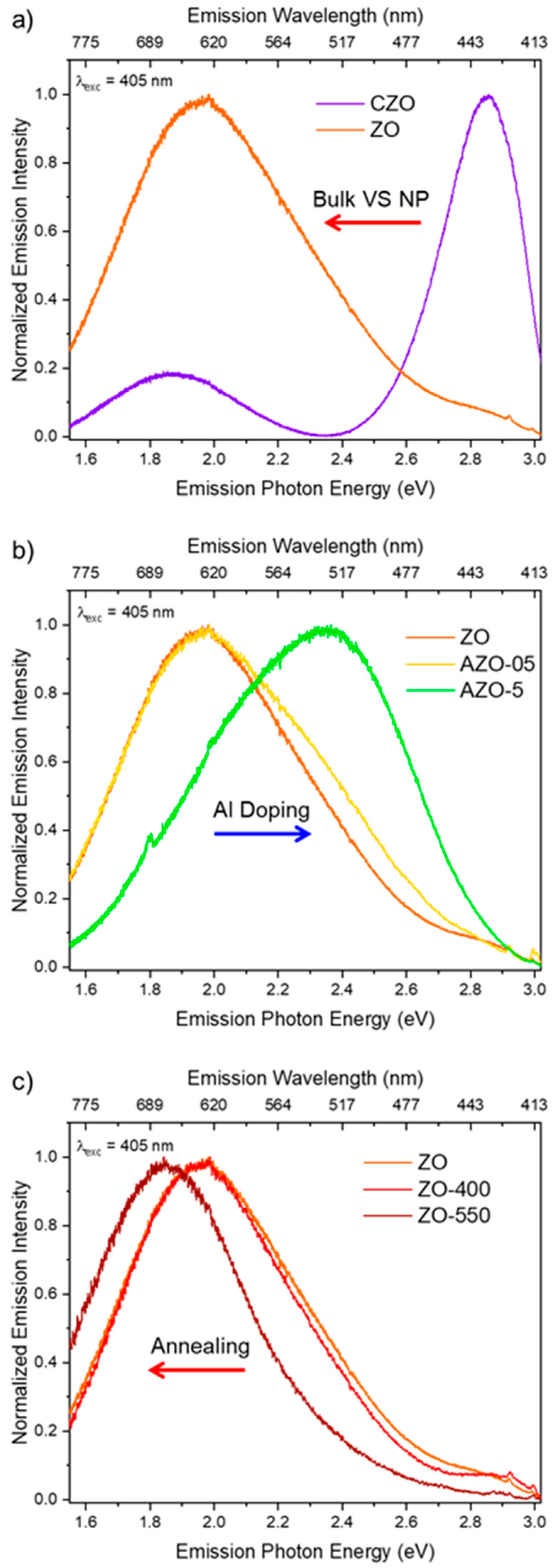Photocatalytic Performance of Undoped and Al-Doped ZnO Nanoparticles in the Degradation of Rhodamine B under UV-Visible Light:The Role of Defects and Morphology
Abstract
1. Introduction
2. Results and Discussion
Photocatalytic Degradation of Rhodamine B Dye
3. Materials and Methods
3.1. Synthesis
3.2. Characterization Techniques
3.3. Photocatalytic Assessment
3.3.1. Photodegradation in the UV Range
3.3.2. Photodegradation in the Visible Range
4. Conclusions
Supplementary Materials
Author Contributions
Funding
Institutional Review Board Statement
Informed Consent Statement
Data Availability Statement
Acknowledgments
Conflicts of Interest
References
- UNESCO. The United Nations World Water Development Report 2020_ Water and Climate Change; UNESCO: Paris, France, 2020. [Google Scholar]
- Lim, H.; Yusuf, M.; Song, S.; Park, S.; Park, K.H. Efficient Photocatalytic Degradation of Dyes Using Photo-Deposited Ag Nanoparticles on ZnO Structures: Simple Morphological Control of ZnO. RSC Adv. 2021, 11, 8709–8717. [Google Scholar] [CrossRef] [PubMed]
- Mahapatra, N.N. Textile Dyes, 1st ed.; Woodhead Publishing India Pvt Ltd.: New Delhi, India, 2016. [Google Scholar]
- Thomas Bechtold, T.P. Textile Chemistry; De Gruyter: Berlin, Germany, 2019. [Google Scholar] [CrossRef]
- Reddy, P.A.K.; Reddy, P.V.L.; Kwon, E.; Kim, K.-H.; Akter, T.; Kalagara, S. Recent Advances in Photocatalytic Treatment of Pollutants in Aqueous Media. Environ. Int. 2016, 91, 94–103. [Google Scholar] [CrossRef] [PubMed]
- Balcha, A.; Yadav, O.P.; Dey, T. Photocatalytic Degradation of Methylene Blue Dye by Zinc Oxide Nanoparticles Obtained from Precipitation and Sol-Gel Methods. Environ. Sci. Pollut. Res. 2016, 23, 25485–25493. [Google Scholar] [CrossRef] [PubMed]
- Dodoo-Arhin, D.; Asiedu, T.; Agyei-Tuffour, B.; Nyankson, E.; Obada, D.; Mwabora, J.M. Photocatalytic Degradation of Rhodamine Dyes Using Zinc Oxide Nanoparticles. Mater. Today Proc. 2021, 38, 809–815. [Google Scholar] [CrossRef]
- Ahlström, L.-H.; Sparr Eskilsson, C.; Björklund, E. Determination of Banned Azo Dyes in Consumer Goods. TrAC Trends Anal. Chem. 2005, 24, 49–56. [Google Scholar] [CrossRef]
- Khan, S.; Malik, A. Toxicity Evaluation of Textile Effluents and Role of Native Soil Bacterium in Biodegradation of a Textile Dye. Environ. Sci. Pollut. Res. 2018, 25, 4446–4458. [Google Scholar] [CrossRef]
- Sansenya, T.; Masri, N.; Chankhanittha, T.; Senasu, T.; Piriyanon, J.; Mukdasai, S.; Nanan, S. Hydrothermal Synthesis of ZnO Photocatalyst for Detoxification of Anionic Azo Dyes and Antibiotic. J. Phys. Chem. Solids 2022, 160, 110353. [Google Scholar] [CrossRef]
- Khataee, A.R.; Pons, M.N.; Zahraa, O. Photocatalytic Degradation of Three Azo Dyes Using Immobilized TiO2 Nanoparticles on Glass Plates Activated by UV Light Irradiation: Influence of Dye Molecular Structure. J. Hazard. Mater. 2009, 168, 451–457. [Google Scholar] [CrossRef]
- John Peter, I.; Praveen, E.; Vignesh, G.; Nithiananthi, P. ZnO Nanostructures with Different Morphology for Enhanced Photocatalytic Activity. Mater. Res. Express 2017, 4, 124003. [Google Scholar] [CrossRef]
- Ani, I.J.; Akpan, U.G.; Olutoye, M.A.; Hameed, B.H. Photocatalytic Degradation of Pollutants in Petroleum Refinery Wastewater by TiO2- and ZnO-Based Photocatalysts: Recent Development. J. Clean. Prod. 2018, 205, 930–954. [Google Scholar] [CrossRef]
- Sinar Mashuri, S.I.; Ibrahim, M.L.; Kasim, M.F.; Mastuli, M.S.; Rashid, U.; Abdullah, A.H.; Islam, A.; Asikin Mijan, N.; Tan, Y.H.; Mansir, N.; et al. Photocatalysis for Organic Wastewater Treatment: From the Basis to Current Challenges for Society. Catalysts 2020, 10, 1260. [Google Scholar] [CrossRef]
- Natarajan, T.S.; Thomas, M.; Natarajan, K.; Bajaj, H.C.; Tayade, R.J. Study on UV-LED/TiO2 Process for Degradation of Rhodamine B Dye. Chem. Eng. J. 2011, 169, 126–134. [Google Scholar] [CrossRef]
- Ayaz, S.; Amin, R.; Samantray, K.; Dasgupta, A.; Sen, S. Tunable Ultraviolet Sensing Performance of Al-Modified ZnO Nanoparticles. J. Alloys Compd. 2021, 884, 161113. [Google Scholar] [CrossRef]
- Saber, O.; El-Brolossy, T.A.; Al Jaafari, A.A. Improvement of Photocatalytic Degradation of Naphthol Green B Under Solar Light Using Aluminum Doping of Zinc Oxide Nanoparticles. Water Air Soil Pollut. 2012, 223, 4615–4626. [Google Scholar] [CrossRef]
- Wu, J.; Xue, D. Progress of Science and Technology of ZnO as Advanced Material. Sci. Adv. Mater. 2011, 3, 127–149. [Google Scholar] [CrossRef]
- Momot, A.; Amini, M.N.; Reekmans, G.; Lamoen, D.; Partoens, B.; Slocombe, D.R.; Elen, K.; Adriaensens, P.; Hardy, A.; Van Bael, M.K. A Novel Explanation for the Increased Conductivity in Annealed Al-Doped ZnO: An Insight into Migration of Aluminum and Displacement of Zinc. Phys. Chem. Chem. Phys. 2017, 19, 27866–27877. [Google Scholar] [CrossRef]
- Buonsanti, R.; Llordes, A.; Aloni, S.; Helms, B.A.; Milliron, D.J. Tunable Infrared Absorption and Visible Transparency of Colloidal Aluminum-Doped Zinc Oxide Nanocrystals. Nano Lett. 2011, 11, 4706–4710. [Google Scholar] [CrossRef]
- Della Gaspera, E.; Chesman, A.S.R.; van Embden, J.; Jasieniak, J.J. Non-Injection Synthesis of Doped Zinc Oxide Plasmonic Nanocrystals. ACS Nano 2014, 8, 9154–9163. [Google Scholar] [CrossRef]
- Garcia, G.; Buonsanti, R.; Runnerstrom, E.L.; Mendelsberg, R.J.; Llordes, A.; Anders, A.; Richardson, T.J.; Milliron, D.J. Dynamically Modulating the Surface Plasmon Resonance of Doped Semiconductor Nanocrystals. Nano Lett. 2011, 11, 4415–4420. [Google Scholar] [CrossRef]
- Jaramillo-Páez, C.; Sánchez-Cid, P.; Navío, J.A.; Hidalgo, M.C. A Comparative Assessment of the UV-Photocatalytic Activities of ZnO Synthesized by Different Routes. J. Environ. Chem. Eng. 2018, 6, 7161–7171. [Google Scholar] [CrossRef]
- Khalid, N.R.; Hammad, A.; Tahir, M.B.; Rafique, M.; Iqbal, T.; Nabi, G.; Hussain, M.K. Enhanced Photocatalytic Activity of Al and Fe Co-Doped ZnO Nanorods for Methylene Blue Degradation. Ceram. Int. 2019, 45, 21430–21435. [Google Scholar] [CrossRef]
- Bazzani, M.; Neroni, A.; Calzolari, A.; Catellani, A. Optoelectronic Properties of Al:ZnO: Critical Dosage for an Optimal Transparent Conductive Oxide. Appl. Phys. Lett. 2011, 98, 121907. [Google Scholar] [CrossRef]
- Abrinaei, F.; Molahasani, N. Effects of Mn Doping on the Structural, Linear, and Nonlinear Optical Properties of ZnO Nanoparticles. J. Opt. Soc. Am. B 2018, 35, 2015. [Google Scholar] [CrossRef]
- Calzolari, A.; Catellani, A. Doping, Co-Doping, and Defect Effects on the Plasmonic Activity of ZnO-Based Transparent Conductive Oxides. Oxide-Based Mater. Devices VIII 2017, 10105, 101050G. [Google Scholar] [CrossRef]
- Yaqoob, A.A.; Mohd Noor, N.H.b.; Serrà, A.; Mohamad Ibrahim, M.N. Advances and Challenges in Developing Efficient Graphene Oxide-Based ZnO Photocatalysts for Dye Photo-Oxidation. Nanomaterials 2020, 10, 932. [Google Scholar] [CrossRef]
- Damm, H.; Adriaensens, P.; De Dobbelaere, C.; Capon, B.; Elen, K.; Drijkoningen, J.; Conings, B.; Manca, J.V.; D’Haen, J.; Detavernier, C.; et al. Factors Influencing the Conductivity of Aqueous Sol(Ution)–Gel-Processed Al-Doped ZnO Films. Chem. Mater. 2014, 26, 5839–5851. [Google Scholar] [CrossRef]
- Kelchtermans, A.; Elen, K.; Schellens, K.; Conings, B.; Damm, H.; Boyen, H.G.; D’Haen, J.; Adriaensens, P.; Hardy, A.; Van Bael, M.K. Relation between Synthesis Conditions, Dopant Position and Charge Carriers in Aluminium-Doped ZnO Nanoparticles. RSC Adv. 2013, 3, 15254–15262. [Google Scholar] [CrossRef]
- Serier, H.; Gaudon, M.; Ménétrier, M. Al-Doped ZnO Powdered Materials: Al Solubility Limit and IR Absorption Properties. Solid State Sci. 2009, 11, 1192–1197. [Google Scholar] [CrossRef]
- Conversion, B. Catalysis for Clean Energy and Environmental Sustainability; Pant, K.K., Gupta, S.K., Ahmad, E., Eds.; Springer International Publishing: Cham, Switzerland, 2021; Volume 1. [Google Scholar] [CrossRef]
- Nandi, P.; Das, D. Photocatalytic Degradation of Rhodamine-B Dye by Stable ZnO Nanostructures with Different Calcination Temperature Induced Defects. Appl. Surf. Sci. 2019, 465, 546–556. [Google Scholar] [CrossRef]
- Munawar, T.; Yasmeen, S.; Hussain, F.; Mahmood, K.; Hussain, A.; Asghar, M.; Iqbal, F. Synthesis of Novel Heterostructured ZnO-CdO-CuO Nanocomposite: Characterization and Enhanced Sunlight Driven Photocatalytic Activity. Mater. Chem. Phys. 2020, 249, 122983. [Google Scholar] [CrossRef]
- Neena, D.; Kondamareddy, K.K.; Bin, H.; Lu, D.; Kumar, P.; Dwivedi, R.K.; Pelenovich, V.O.; Zhao, X.-Z.; Gao, W.; Fu, D. Enhanced Visible Light Photodegradation Activity of RhB/MB from Aqueous Solution Using Nanosized Novel Fe-Cd Co-Modified ZnO. Sci. Rep. 2018, 8, 10691. [Google Scholar] [CrossRef]
- Burdett, J.K.; Price, G.D.; Price, S.L. Role of the Crystal-Field Theory in Determining the Structures of Spinels. J. Am. Chem. Soc. 1982, 104, 92–95. [Google Scholar] [CrossRef]
- Kelchtermans, A.; Adriaensens, P.; Slocombe, D.; Kuznetsov, V.L.; Hadermann, J.; Riskin, A.; Elen, K.; Edwards, P.P.; Hardy, A.; Van Bael, M.K. Increasing the Solubility Limit for Tetrahedral Aluminium in ZnO:Al Nanorods by Variation in Synthesis Parameters. J. Nanomater. 2015, 2015, 5. [Google Scholar] [CrossRef]
- Tsubota, T.; Ohtaki, M.; Eguchi, K.; Arai, H. Thermoelectric Properties of Al-Doped ZnO as a Promising Oxide Material for High-Temperature Thermoelectric Conversion. J. Mater. Chem. 1997, 7, 85–90. [Google Scholar] [CrossRef]
- Wan Shick, H.; De Jonghe, L.C.; Xi, Y.; Rahaman, M.N. Reaction Sintering of ZnO-Al2O3. J. Am. Ceram. Soc. 1995, 78, 3217–3224. [Google Scholar]
- Thu, T.V.; Maenosono, S. Synthesis of High-Quality Al-Doped ZnO Nanoink. J. Appl. Phys. 2010, 107, 014308. [Google Scholar] [CrossRef]
- Serier, H.; Demourgues, A.; Majimel, J.; Gaudon, M. Infrared Absorptive Properties of Al-Doped ZnO Divided Powder. J. Solid State Chem. 2011, 184, 1523–1529. [Google Scholar] [CrossRef]
- Suwanboon, S.; Amornpitoksuk, P.; Haidoux, A.; Tedenac, J.C. Structural and Optical Properties of Undoped and Aluminium Doped Zinc Oxide Nanoparticles via Precipitation Method at Low Temperature. J. Alloys Compd. 2008, 462, 335–339. [Google Scholar] [CrossRef]
- Kumar, R.S.; Sathyamoorthy, R.; Sudhagar, P.; Matheswaran, P.; Hrudhya, C.P.; Kang, Y.S. Effect of Aluminum Doping on the Structural and Luminescent Properties of ZnO Nanoparticles Synthesized by Wet Chemical Method. Phys. E Low-Dimens. Syst. Nanostruct. 2011, 43, 1166–1170. [Google Scholar] [CrossRef]
- Hartner, S.; Ali, M.; Schulz, C.; Winterer, M.; Wiggers, H. Electrical Properties of Aluminum-Doped Zinc Oxide (AZO) Nanoparticles Synthesized by Chemical Vapor Synthesis. Nanotechnology 2009, 20, 445701. [Google Scholar] [CrossRef]
- Brehm, J.U.; Winterer, M.; Hahn, H. Synthesis and Local Structure of Doped Nanocrystalline Zinc Oxides. J. Appl. Phys. 2006, 100, 064311. [Google Scholar] [CrossRef]
- Kelchtermans, A. Synthesis and In-Depth Characterization of Al-Doped ZnO Nanoparticles as Building Blocks for TCO Layers. Ph.D. Thesis, Hasselt University, Hasselt, Belgium, 2014. [Google Scholar]
- Pinna, N.; Garnweitner, G.; Antonietti, M.; Niederberger, M. A General Nonaqueous Route to Binary Metal Oxide Nanocrystals Involving a C−C Bond Cleavage. J. Am. Chem. Soc. 2005, 127, 5608–5612. [Google Scholar] [CrossRef] [PubMed]
- Avadhut, Y.S.; Weber, J.; Hammarberg, E.; Feldmann, C.; Schmedtaufder Günne, J. Structural Investigation of Aluminium Doped ZnO Nanoparticles by Solid-State NMR Spectroscopy. Phys. Chem. Chem. Phys. 2012, 14, 11610–11625. [Google Scholar] [CrossRef]
- Titova, Y.Y.; Schmidt, F.K. What 27Al NMR Spectroscopy Can Offer to Study of Multicomponent Catalytic Hydrogenation Systems? J. Organomet. Chem. 2022, 975, 122410. [Google Scholar] [CrossRef]
- Roberts, N.; Wang, R.; Sleight, A.W. And Impurity Nuclear Magnetic Resonance in ZnO:Al and ZnO:Ga. Phys. Rev. B Condens. Matter Mater. Phys. 1998, 57, 5734–5741. [Google Scholar] [CrossRef]
- Knight, W.D. Nuclear Magnetic Resonance Shift in Metals. Phys. Rev. 1949, 76, 1259–1260. [Google Scholar] [CrossRef]
- Achehboune, M.; Khenfouch, M.; Boukhoubza, I.; Leontie, L.; Doroftei, C.; Carlescu, A.; Bulai, G.; Mothudi, B.; Zorkani, I.; Jorio, A. Microstructural, FTIR and Raman Spectroscopic Study of Rare Earth Doped ZnO Nanostructures. Mater. Today Proc. 2022, 53, 319–323. [Google Scholar] [CrossRef]
- Djelloul, A.; Aida, M.S.; Bougdira, J. Photoluminescence, FTIR and X-ray Diffraction Studies on Undoped and Al-Doped ZnO Thin Films Grown on Polycrystalline α-Alumina Substrates by Ultrasonic Spray Pyrolysis. J. Lumin. 2010, 130, 2113–2117. [Google Scholar] [CrossRef]
- Mojumder, S.; Das, T.; Das, S.; Chakraborty, N.; Saha, D.; Pal, M. Y and Al Co-Doped ZnO-Nanopowder Based Ultrasensitive Trace Ethanol Sensor: A Potential Breath Analyzer for Fatty Liver Disease and Drunken Driving Detection. Sens. Actuators B Chem. 2022, 372, 132611. [Google Scholar] [CrossRef]
- Zhang, X.; Chen, Y.; Zhang, S.; Qiu, C. High Photocatalytic Performance of High Concentration Al-Doped ZnO Nanoparticles. Sep. Purif. Technol. 2017, 172, 236–241. [Google Scholar] [CrossRef]
- Munawaroh, H.; Wahyuningsih, S.; Ramelan, A.H. Synthesis and Characterization of Al Doped ZnO (AZO) by Sol-Gel Method. IOP Conf. Ser. Mater. Sci. Eng. 2017, 176, 012049. [Google Scholar] [CrossRef]
- Sowri Babu, K.; Ramachandra Reddy, A.; Sujatha, C.; Venugopal Reddy, K.; Mallika, A.N. Synthesis and Optical Characterization of Porous ZnO. J. Adv. Ceram. 2013, 2, 260–265. [Google Scholar] [CrossRef]
- Mihai, G.D.; Meynen, V.; Mertens, M.; Bilba, N.; Cool, P.; Vansant, E.F. ZnO Nanoparticles Supported on Mesoporous MCM-41 and SBA-15: A Comparative Physicochemical and Photocatalytic Study. J. Mater. Sci. 2010, 45, 5786–5794. [Google Scholar] [CrossRef]
- Liao, Y.; Xie, C.; Liu, Y.; Chen, H.; Li, H.; Wu, J. Comparison on Photocatalytic Degradation of Gaseous Formaldehyde by TiO2, ZnO and Their Composite. Ceram. Int. 2012, 38, 4437–4444. [Google Scholar] [CrossRef]
- Collard, X.; El Hajj, M.; Su, B.-L.; Aprile, C. Synthesis of Novel Mesoporous ZnO/SiO2 Composites for the Photodegradation of Organic Dyes. Microporous Mesoporous Mater. 2014, 184, 90–96. [Google Scholar] [CrossRef]
- Ajala, F.; Hamrouni, A.; Houas, A.; Lachheb, H.; Megna, B.; Palmisano, L.; Parrino, F. The Influence of Al Doping on the Photocatalytic Activity of Nanostructured ZnO: The Role of Adsorbed Water. Appl. Surf. Sci. 2018, 445, 376–382. [Google Scholar] [CrossRef]
- Hamrouni, A.; Moussa, N.; Parrino, F.; Di Paola, A.; Houas, A.; Palmisano, L. Sol-Gel Synthesis and Photocatalytic Activity of ZnO-SnO2 Nanocomposites. J. Mol. Catal. A Chem. 2014, 390, 133–141. [Google Scholar] [CrossRef]
- Amalia, F.R.; Takashima, M.; Ohtani, B. Are You Still Using Organic Dyes? Colorimetric Formaldehyde Analysis for True Photocatalytic-Activity Evaluation. Chem. Commun. 2022, 58, 11721–11724. [Google Scholar] [CrossRef]
- Schuster, A. Radiation Through a Foggy Atmosphere. Astrophys. J. 1905, 21, 1. [Google Scholar] [CrossRef]
- Kubelka, P.; Munk, F.; KUBELKA, P. Ein Beitrag Zur Optik Der Farbanstriche. Z. Tech. Phys. 1931, 12, 593–601. [Google Scholar]
- Kubelka, P. New Contributions to the Optics of Intensely Light-Scattering Materials Part I. J. Opt. Soc. Am. 1948, 38, 448. [Google Scholar] [CrossRef]
- Kubelka, P. New Contributions to the Optics of Intensely Light-Scattering Materials Part II: Nonhomogeneous Layers. J. Opt. Soc. Am. 1954, 44, 330. [Google Scholar] [CrossRef]
- Zanatta, A.R. Revisiting the Optical Bandgap of Semiconductors and the Proposal of a Unified Methodology to Its Determination. Sci. Rep. 2019, 9, 11225. [Google Scholar] [CrossRef] [PubMed]
- Paramo, J.A.; Strzhemechny, Y.M.; Endo, T.; Crnjak Orel, Z. Correlation of Defect-Related Optoelectronic Properties in Zn5(OH)6(CO3)2/ZnO Nanostructures with Their Quasi-Fractal Dimensionality. J. Nanomater. 2015, 2015, 237985. [Google Scholar] [CrossRef]
- Zhang, M.; Averseng, F.; Haque, F.; Borghetti, P.; Krafft, J.M.; Baptiste, B.; Costentin, G.; Stankic, S. Defect-Related Multicolour Emissions in ZnO Smoke: From Violet, over Green to Yellow. Nanoscale 2019, 11, 5102–5115. [Google Scholar] [CrossRef] [PubMed]
- Pal, M.; Bera, S.; Sarkar, S.; Jana, S. Influence of Al Doping on Microstructural, Optical and Photocatalytic Properties of Sol–Gel Based Nanostructured Zinc Oxide Films on Glass. RSC Adv. 2014, 4, 11552–11563. [Google Scholar] [CrossRef]






| Sample Type | Sample Code | Nominal Al Concentration (at%) | Annealing in N2 Flow |
|---|---|---|---|
| Commercial ZnO | CZO | 0 | / |
| Undoped ZnO | ZO | 0 | / |
| Undoped ZnO | ZO-400 | 0 | 400 °C/10 min |
| Undoped ZnO | ZO-550 | 0 | 550 °C/10 min |
| Al-doped ZnO | AZO-05 | 0.5 | / |
| Al-doped ZnO | AZO-05-400 | 0.5 | 400 °C/10 min |
| Al-doped ZnO | AZO-05-550 | 0.5 | 550 °C/10 min |
| Al-doped ZnO | AZO-1 | 1 | / |
| Al-doped ZnO | AZO-2 | 2 | / |
| Al-doped ZnO | AZO-3 | 3 | / |
| Al-doped ZnO | AZO-5 | 5 | / |
| Al-doped ZnO | AZO-5-400 | 5 | 400 °C/10 min |
| Al-doped ZnO | AZO-5-550 | 5 | 550 °C/10 min |
| Sample Codes | RhB Dye Degradation [%] UV-C 254 nm | RhB Dye Degradation [%] UV-A 368 nm |
|---|---|---|
| CZO | 94 ± 1 | 95.9 ± 0.1 |
| ZO | 44.6 ± 0.5 | 70 ± 3 |
| AZO-05 | 41 ± 2 | 53 ± 2 |
| AZO-5 | 21 ± 2 | 19 ± 3 |
| RhB Dye Degradation (%) under Green Light (525 nm) | ||||
|---|---|---|---|---|
| Sample Codes | Reaction Time | Not Annealed | 400 °C in N2 | 550 °C in N2 |
| CZO | 1 h | 20 ± 4 | 20 ± 4 | 19 ± 2 |
| ZO | 1 h | 39 ± 1 | 50 ± 3 | 21 ± 1 |
| AZO-05 | 1 h | 26 ± 2 | 21.7 ± 0.5 | 25 ± 1 |
| AZO-5 | 1 h | 21 ± 2 | 22 ± 1 | 23 ± 1 |
| ZO | 4 h | 64 ± 2 | 81 ± 4 | 51.3 ± 0.5 |
Publisher’s Note: MDPI stays neutral with regard to jurisdictional claims in published maps and institutional affiliations. |
© 2022 by the authors. Licensee MDPI, Basel, Switzerland. This article is an open access article distributed under the terms and conditions of the Creative Commons Attribution (CC BY) license (https://creativecommons.org/licenses/by/4.0/).
Share and Cite
Piras, A.; Olla, C.; Reekmans, G.; Kelchtermans, A.-S.; De Sloovere, D.; Elen, K.; Carbonaro, C.M.; Fusaro, L.; Adriaensens, P.; Hardy, A.; et al. Photocatalytic Performance of Undoped and Al-Doped ZnO Nanoparticles in the Degradation of Rhodamine B under UV-Visible Light:The Role of Defects and Morphology. Int. J. Mol. Sci. 2022, 23, 15459. https://doi.org/10.3390/ijms232415459
Piras A, Olla C, Reekmans G, Kelchtermans A-S, De Sloovere D, Elen K, Carbonaro CM, Fusaro L, Adriaensens P, Hardy A, et al. Photocatalytic Performance of Undoped and Al-Doped ZnO Nanoparticles in the Degradation of Rhodamine B under UV-Visible Light:The Role of Defects and Morphology. International Journal of Molecular Sciences. 2022; 23(24):15459. https://doi.org/10.3390/ijms232415459
Chicago/Turabian StylePiras, Alessandra, Chiara Olla, Gunter Reekmans, An-Sofie Kelchtermans, Dries De Sloovere, Ken Elen, Carlo Maria Carbonaro, Luca Fusaro, Peter Adriaensens, An Hardy, and et al. 2022. "Photocatalytic Performance of Undoped and Al-Doped ZnO Nanoparticles in the Degradation of Rhodamine B under UV-Visible Light:The Role of Defects and Morphology" International Journal of Molecular Sciences 23, no. 24: 15459. https://doi.org/10.3390/ijms232415459
APA StylePiras, A., Olla, C., Reekmans, G., Kelchtermans, A.-S., De Sloovere, D., Elen, K., Carbonaro, C. M., Fusaro, L., Adriaensens, P., Hardy, A., Aprile, C., & Van Bael, M. K. (2022). Photocatalytic Performance of Undoped and Al-Doped ZnO Nanoparticles in the Degradation of Rhodamine B under UV-Visible Light:The Role of Defects and Morphology. International Journal of Molecular Sciences, 23(24), 15459. https://doi.org/10.3390/ijms232415459











